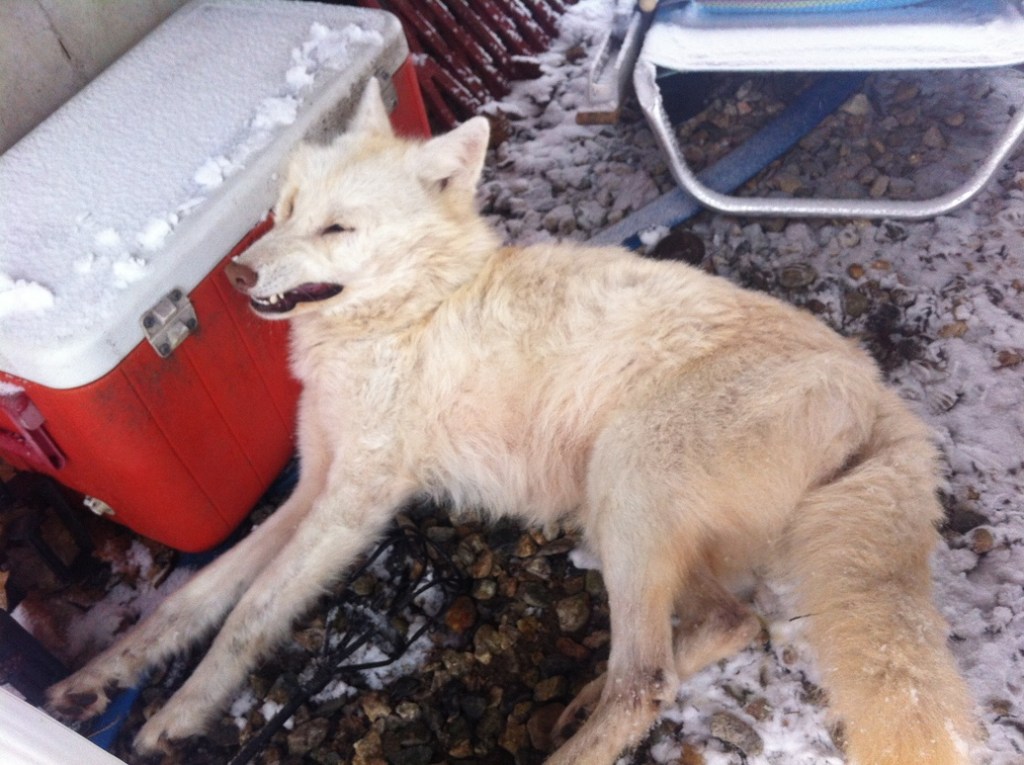KENNEBUNK — An animal that resembled an albino wolf staggered out of the woods behind a home on Balsam Lane in Kennebunk last week, crawled under the house’s back porch and lay down to die.
And the mystery had only begun as the home’s owners, local police, game wardens and finally a state wildlife biologist tried to figure out what kind of creature had wandered into the yard.
Some non-scientists thought it was a rare white wolf — there is no known wolf population in Maine — while others said it could be a dog or even a hybrid, a cross between a dog and a coyote.
Regional Wildlife Biologist Scott Lindsay put the speculation to rest Monday, three days after taking the remains to his offices in Gray for a morphological examination. He measured the animal’s cranial area and examined its teeth. He determined that it weighed 37 pounds and was just under a year old.
The animal also had very white teeth that were longer than a domestic animal’s. Dogs typically have teeth discolored by the buildup of tartar from eating dog food, Lindsay said.
“All of those measurements and factors lead me to believe it’s a white coyote,” Lindsay said Monday night. “That’s what threw me off, the color. I have never seen a white coyote before.”
Coyotes are usually a gray or beige color. White coyotes are extremely rare, Lindsay said. The last white coyote seen in Maine was trapped a few years ago in the town of Patten near Baxter State Park, he said.
Earlier this year, an article in National Geographic Magazine reported that occasional sightings of white coyotes began surfacing in Newfoundland in 2003.
The Newfoundland Department of Environment and Conservation collects coyote carcasses for research purposes and found that out of the 6,000 specimens they’ve collected, six were white.
National Geographic said the coyotes were not albino but more like Arctic foxes or polar bears whose genes turn their coats white while allowing them to continue making pigment in their skin and eyes. Newfoundlanders have started calling the animals snow coyotes.
The article says evidence shows that the same genetic mutations are occurring in the black bear gene pool in British Columbia, where bears with white coats, called spirit bears, have reared black cubs.
Lindsay said the Kennebunk coyote, which is in a refrigerated container at the Gray offices, does have a very subtle yellowish tinge to its outer fur — a shaggy coat that sheds water and retains heat during the winter months. From a distance, though, the animal looks white.
“It’s simply a (genetic) mutation, ” Lindsay said of its fur color.
The cause of death — there were no broken bones or gunshot wounds on the coyote — remains unknown and Lindsay said the only sure way to determine the cause would be to do a necropsy.
He’s holding off on cutting the animal open because the state may want to have the animal preserved by a taxidermist and placed on display at a place like the Maine Wildlife Park in Gray.
“It was a beautiful animal,” said Ed Larrivee of Arundel, friend of the Kennebunk homeowners and experienced hunter who went to see the animal after the family contacted him.
Larrivee said he examined the coyote’s eyes – they were brown – and looked for but did not find any signs of wounds or injuries. He also took photos of the coyote with its head propped up against a cooler stored under the porch.
“I’m guessing that it was a young coyote that got hit by a car and suffered internal injuries,” said Geri Vistein, a conservation biologist based in Washington, which is between Augusta and Camden.
Vistein specializes in coyote research and has consulted with the city of Biddeford on how to manage its coyote population. She travels around the state and maintains a website – www.coyotelivesinmaine.com – aimed at educating and informing the public about the role of coyotes in the environment.
When an animal is sick or wounded, it oftentimes separates from its family and goes off to die, which is what may have happened in this case, she said.
Vistein said coyotes are a very social, highly evolved and intelligent species that is important to the state’s ecosystem.
“I personally believe we don’t have enough coyotes in Maine,” she said.
Lt. Anthony Bean Burpee of the Kennebunk Police Department said the residents of the home on Balsam Lane notified police on Monday of last week that a dog had wandered into their yard and died.
Burpee said police officers typically do not remove dead animals. The same goes for the warden service, he said.
The homeowner made arrangements to have the dead animal relocated to a remote area behind a business in Alfred, which is where Lindsay found it.
Attempts to reach the homeowner, who took photos of the white coyote, were unsuccessful.
Staff Writer Dennis Hoey can be contacted at 791-6365 or at:
dhoey@pressherald.com
Send questions/comments to the editors.




Success. Please wait for the page to reload. If the page does not reload within 5 seconds, please refresh the page.
Enter your email and password to access comments.
Hi, to comment on stories you must . This profile is in addition to your subscription and website login.
Already have a commenting profile? .
Invalid username/password.
Please check your email to confirm and complete your registration.
Only subscribers are eligible to post comments. Please subscribe or login first for digital access. Here’s why.
Use the form below to reset your password. When you've submitted your account email, we will send an email with a reset code.